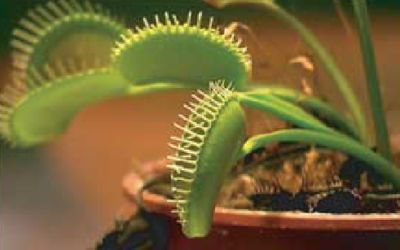Venus Flytrap's Speed Secret Revealed

The carnivorous Venus flytrap plant can snap its clamshell leaves around an insect in less than a second. But how?
Unlike animals, plants have no muscles or brains. And plants are not known for their ability to move quickly, as a team of scientists and engineers point out in the Jan. 27 issue of the journal Nature.
The secret has been revealed: The flytrap's leaves snap from convex to concave the same way that a contact lens can flip inside out, the scientists say.
((ImgTag||right|null|null|null|false)) A leaf closes in 0.04 seconds. Colors indicate changing curvature. Credit: Nature
The team cut up leaves to study their natural curls, and also painted fluorescent dots on intact leaves to track their insect-devouring action with high-speed cameras.
Like most lenses, Venus flytrap leaves are doubly curved, that is, curved in two directions, which allows the leaves to store elastic energy.
With a contact lens, the two directions are perpendicular to one another. With a Venus flytrap leaf, they are not. That property creates an especially rapid elasticity that causes the leaf to snap even more quickly from convex to concave.
Tennis ball science
Sign up for the Live Science daily newsletter now
Get the world’s most fascinating discoveries delivered straight to your inbox.
Bending and stretching are inseparable for doubly curved objects.
"Think of a cut-open tennis ball," said L. Mahadevan of Harvard University, who is part of the team that came with the new explanation of the Venus flytrap's snapping. "If you try to bend it, you end up stretching it as well."
Large, highly curved leaves snap more rapidly than smaller, weakly curved leaves. Overall, this action is called snap buckling.
The question of what initiates the snap buckling remains unanswered. It starts when stiff hairs on the leaves' edges are touched.
Mahadevan and others suspect some high-pressure movement of water through the leaves makes them start to curl in a way that initiates the snap buckling. Mahadevan's colleague Yoel Forterre of the University of Provence in France is working on that problem.
A vegetarian's delight
Mahadevan says his interest in Venus flytrap snapping became especially piqued when a colleague gave him one of the carnivorous plants as a gift. "I thought it would be fun to study it," he told LiveScience. "Besides, as a vegetarian, it is nice to think about plants that eat animals rather than the other way around!"
Venus flytraps, which live only in bogs in North and South Carolina and have become endangered, can gather nutrients from gases in the air and the soil, but they prefer poor soil and are healthier if they consume a meaty housefly or two every month.
Once an insect is captured, the plant closes its trap tightly around the meal and bathes it in digestive juices that dissolve the insect's soft, inner parts.
Digestion takes five to 12 days, after which the trap reopens. The insect's exoskeleton blows away in the wind or is washed away by rain.
Venus flytraps exhibit one of the fastest movements in the plant kingdom, competing in speed tests with the exploding fruits of flowering plants. In these plants, ovaries mature around fertilized eggs to form fruits that protect the developing embryos inside. In certain case, as with impatiens, squirting cucumbers, and trigger plants, the fruits explode on contact, an adaptation that favors the dispersal of seeds over their protection.
Robin Lloyd was a senior editor at Space.com and Live Science from 2007 to 2009. She holds a B.A. degree in sociology from Smith College and a Ph.D. and M.A. degree in sociology from the University of California at Santa Barbara. She is currently a freelance science writer based in New York City and a contributing editor at Scientific American, as well as an adjunct professor at New York University's Science, Health and Environmental Reporting Program.










